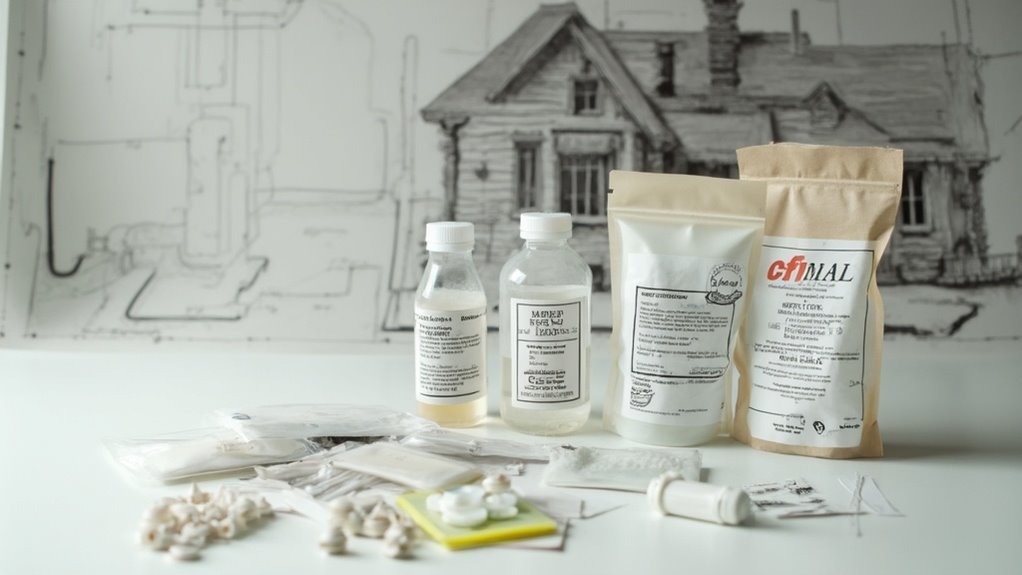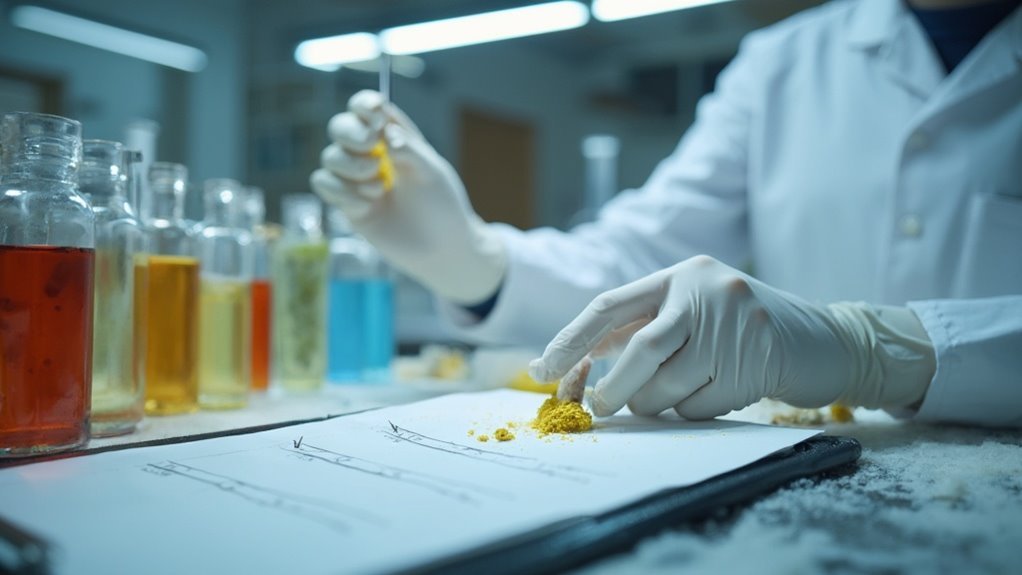To get accurate asbestos test results, engage certified professionals to conduct thorough assessments of your property. They use methods like Polarized Light Microscopy or Transmission Electron Microscopy, ensuring reliable identification. Understand that test results indicate varying levels of risk; you'll need immediate action for high contamination levels, while minimal risks may allow for ongoing monitoring. Review laboratory reports carefully, confirming details for accuracy. Consulting experts will guide your next steps, ensuring safe management practices and compliance with regulations. By understanding these aspects, you can make well-considered choices about your property's health and safety. More insights await on effective strategies and regulations.
Importance of Accurate Testing

Accurate asbestos testing is fundamental for safeguarding health and ensuring regulatory compliance. By adhering to asbestos regulations, you protect not just yourself but likewise workers, residents, and the public from potential hazards. Accurate testing identifies hidden asbestos, which can lurk in construction materials and lead to severe long-term health issues, including asbestosis, mesothelioma, and lung cancer. Professional testing is essential to ensure that asbestos is handled safely and accurately detected.
In addition, certified inspectors conduct thorough property assessments to confirm asbestos presence, ensuring no potential risks are overlooked. Early detection allows for timely intervention, minimizing health risks and providing peace of mind. If no asbestos is detected, you gain reassurance; if it is found, you can take knowledgeable action. This proactive approach improves property value, as asbestos-free properties are intrinsically safer and more desirable.
Engaging certified professionals for testing guarantees reliable results, critical for making educated choices about remediation. These experts possess the necessary tools, knowledge, and experience to manage hazardous materials safely. They'll guide you on compliant removal methods, ensuring you meet health compliance standards.
Inaccurate testing can lead to dire consequences, including health risks, legal penalties, and reduced property value. Therefore, prioritizing accurate testing is important for maintaining safety and compliance with asbestos regulations, ultimately protecting your health and investment.
Testing Methods Overview
When evaluating potential asbestos hazards, understanding the various testing methods is crucial for effective risk management. Asbestos identification techniques primarily involve bulk sample analysis, with Polarized Light Microscopy (PLM) being the standard method for materials like floor tiles and wall textures. PLM distinguishes asbestos from other minerals, serving as the initial step in determining asbestos content. For more detailed evaluations, Transmission Electron Microscopy (TEM) provides higher magnification and is particularly useful for analyzing fine fibers.
When analyzing air samples, Phase Contrast Microscopy (PCM) offers a preliminary screening method; yet, it can't definitively identify asbestos. For accurate fiber analysis, TEM again excels in identifying and characterizing airborne asbestos fibers, especially at low concentrations.
Additionally, point counting is necessary for samples containing less than 10% asbestos, ensuring precise quantification to avoid unnecessary remediation. Gravimetric point count methods complement these techniques but are not suitable for friable materials. Understanding these fiber analysis methods allows you to make well-informed choices regarding asbestos remediation and safety measures, ensuring a thorough evaluation of potential risks in your property. Professional testing is essential for accurate identification and quantification of asbestos in various materials.
Understanding Test Results

When you review your asbestos test results, understanding the implications of a positive finding is essential. The severity of contamination will dictate your abatement strategy, as low levels may only require monitoring while high levels necessitate immediate removal. Accurate interpretation of these results guarantees you take the right steps to protect your health and comply with safety regulations.
Positive Result Implications
Interpreting positive asbestos test results can feel overwhelming, but understanding the implications is fundamental for guaranteeing safety. A positive result indicates the presence of asbestos fibers, which pose significant health risks, including lung cancer and mesothelioma, particularly when these fibers become airborne. This necessitates immediate action to mitigate exposure.
You must recognize your legal obligations as a property owner. Once you confirm asbestos presence, you're required to ascertain the safety of all inhabitants, which may involve creating a detailed asbestos abatement plan. Professional testing services are imperative, as they provide accurate results and help determine the extent of contamination. The severity of asbestos found can vary; low levels may require less extensive abatement, while high levels demand urgent intervention.
Engaging licensed asbestos abatement professionals is critical for compliance with regulations and to guarantee safe removal and disposal of affected materials. These experts will guide you on the best course of action, whether that's encapsulating the asbestos or complete removal. Ultimately, prioritizing the safety of residents should drive your decisions during this complex process.
Contamination Severity Levels
Understanding the severity levels of asbestos contamination is vital for determining the necessary actions following a positive test result. There are four distinct levels of contamination, each with specific implications for health risks and regulatory compliance.
At Severity Level 1, minimal contamination occurs with asbestos concentrations below 0.01 fibers per cubic centimeter (f/cc). This level typically doesn't require immediate action but requires ongoing monitoring.
Severity Level 2 indicates moderate contamination, with asbestos levels ranging from 0.01 to 0.1 f/cc. Here, you'll need to evaluate the source and conduct a risk assessment, as this level can pose moderate health risks and may require containment or minor abatement measures.
In Severity Level 3, significant contamination is present, with levels exceeding 0.1 f/cc. This situation demands immediate abatement and poses serious health risks, including asbestosis. Professional services are necessary, and you must guarantee compliance with asbestos regulations.
Finally, Severity Level 4 represents critical contamination, with concentrations exceeding 1 f/cc, necessitating immediate evacuation and extensive remediation. Regulatory authorities may likewise need to be notified because of the high health risks involved.
Abatement Strategy Determination
Properly determining an abatement strategy is crucial after receiving asbestos test results, as the specific type of asbestos and its condition greatly influence the necessary actions. Understanding the types of asbestos fibers found in your property, such as Chrysotile or Crocidolite, is essential for evaluating risk and formulating an appropriate plan.
| Abatement Technique | Best Used When | Risk Level |
|---|---|---|
| Removal | Asbestos is severely damaged | High risk of exposure |
| Encapsulation | Asbestos is in good condition | Moderate risk |
| Enclosure | Asbestos is stable but in a high-traffic area | Low risk of disturbance |
A detailed risk evaluation will help you decide whether removal, encapsulation, or enclosure is necessary. Each abatement technique has its specific applications based on the material's condition and potential disturbance. Consulting with certified professionals will help you develop a thorough strategy that adheres to safety standards and regulatory requirements. Remember, accurate interpretation of test results is critical for effective abatement and long-term safety.
Interpreting Positive Results
When you receive positive asbestos test results, it's vital to assess the severity of the contamination, as this directly influences the necessary abatement actions. Different levels of asbestos fibers detected can signify varying degrees of risk. Low-level contamination may only require minimal intervention, while high levels demand immediate and thorough abatement to protect health and safety.
To accurately interpret your results, carefully review the asbestos test certificate. Confirm it includes the correct site address, reference number, sample locations, and identified fiber types such as Chrysotile or Amosite. Understanding the difference between friable and non-friable asbestos is significant; friable asbestos poses a greater risk because of its potential to release fibers into the air.
Comparing Testing Methods

After interpreting your asbestos test results, it's important to evaluate the various testing methods available for asbestos identification and quantification. Each method has its strengths and weaknesses, influencing your testing method selection based on your specific needs. Transmission Electron Microscopy (TEM) offers high accuracy, particularly for identifying smaller asbestos fiber types, and is often mandated by regulatory bodies for schools and commercial buildings. Nevertheless, its cost and technical requirements can be prohibitive.
Scanning Electron Microscopy (SEM) is a cost-effective alternative with improved accuracy and a greater field of view, making it suitable for field use. While it requires less stringent training, it still delivers reliable results.
Phase Contrast Microscopy (PCM) is the most common method used in asbestos abatement because of its speed and lower cost. On the other hand, it has notable limitations: it can't distinguish between asbestos and non-asbestos fibers, and may miss smaller fibers, potentially leading to false positives.
Ultimately, the choice of method should consider accuracy, cost, convenience, and specific regulatory requirements, ensuring you obtain the most reliable results for your property.
Role of Professionals
The role of certified professionals in asbestos testing and abatement is critical for guaranteeing safety and compliance with regulatory standards. Asbestos professionals undergo rigorous training in disciplines outlined by the EPA Asbestos Model Accreditation Plan, including roles such as Inspector and Management Planner. This training, coupled with annual refresher courses, guarantees they stay updated on the latest practices and certification standards.
When you hire certified professionals, you gain access to their expertise in accurately identifying and evaluating asbestos-containing materials. They utilize proper equipment and protective gear to handle potentially hazardous materials safely, preventing the spread of airborne asbestos during testing and removal. In addition, these experts formulate detailed abatement plans that comply with local regulations, guaranteeing safe removal and disposal of asbestos.
Certified professionals likewise perform crucial post-abatement air quality tests to confirm that no asbestos fibers remain in the environment, safeguarding your property and health. By relying on their specialized knowledge and skills, you greatly reduce the risks associated with asbestos, guaranteeing that your property remains compliant and safe.
Next Steps After Testing

Understanding the results of your asbestos testing is vital for determining the appropriate next steps. First, review the laboratory report to confirm if asbestos is present and assess its concentration. Check for accuracy by verifying site addresses and sample reference numbers match. If asbestos is detected, identify the fiber types, as this will influence your action plan.
Consult a certified professional to evaluate whether the asbestos should be left undisturbed, encapsulated, or removed. High levels of contamination require immediate action, and a detailed abatement plan must comply with asbestos regulations for safe disposal. Avoid any DIY removal, as improper handling can worsen exposure risks.
During removal, professionals should seal off the area and use protective gear to prevent fiber spread. Wetting materials prior to removal can likewise minimize dust release. After the asbestos is disposed of safely, conduct post-removal testing to verify air quality meets safety standards. Regular inspections are fundamental to monitor for potential re-contamination and maintain a safe environment. Ultimately, staying informed and compliant with regulations will protect your property and health in the long run.
Frequently Asked Questions
How Often Should Asbestos Testing Be Conducted in Older Buildings?
You should conduct asbestos testing at least annually for older buildings, following building maintenance guidelines. Increased frequency is necessary if materials show damage, occupancy is high, or renovation plans are in place.
Can I Perform Asbestos Tests Myself at Home?
You can attempt DIY testing at home, but it poses significant risks to your safety. Inaccurate sampling and inadequate protective gear may lead to exposure. Professional assessment guarantees accurate results and better home safety.
What Are the Health Risks of Asbestos Exposure?
Asbestos exposure can lead to devastating asbestos diseases, often lurking silently for decades. You might experience exposure symptoms like persistent cough or chest pain, indicating severe lung damage. Regular check-ups are crucial for timely diagnosis and intervention.
How Long Does It Take to Receive Test Results?
You'll typically receive results within a week, depending on the testing timeline and sample complexity. Understanding the result interpretation is essential, as factors like sample collection and lab analysis greatly influence the timing and accuracy.
What Should I Do if Asbestos Is Found?
If you find asbestos, prioritize professional guidance. Assess the material's condition and potential risk. Depending on the situation, you may need asbestos removal or encapsulation to guarantee safety and compliance with regulations. Always consult experts.
